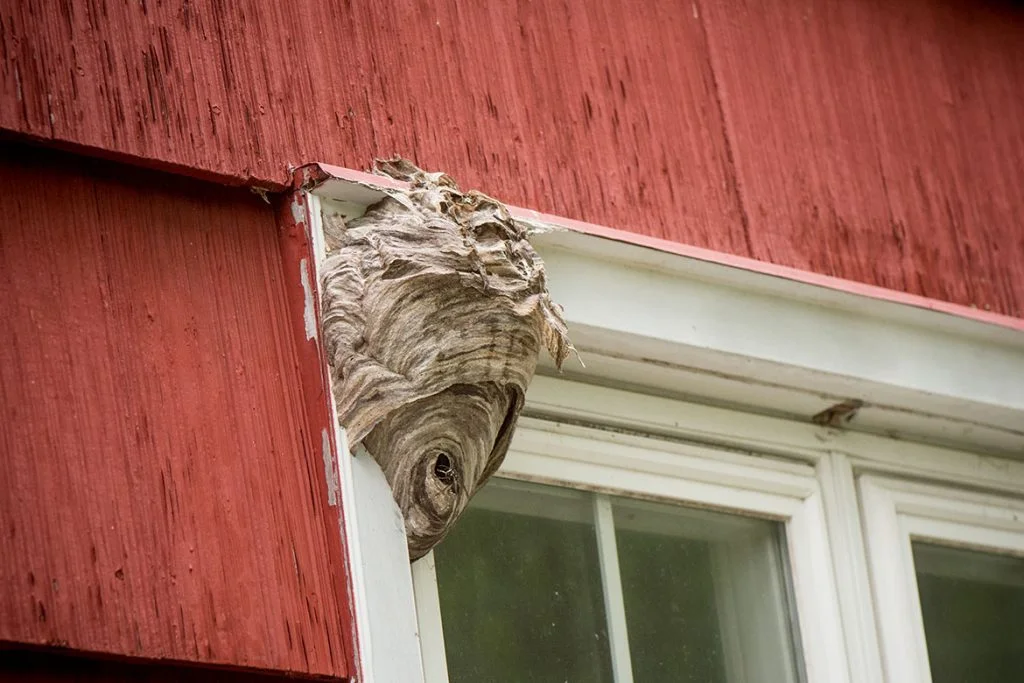A wasp nest is medium-sized or a giant nursery where the insect hatches and rears new wasps with the help of other nest members. The nest is made from a mixture of chewed-up wood fibres and saliva that the wasps create by chewing on wood or plant material. The nest is constructed in layers, each consisting of cells where the wasps lay their eggs and rear their young. The colours of the nests vary from light gray to dark brown or even black. Wasps usually built their nests in sheltered spots with easy access to the outside. They can be found in various locations, including trees, bushes, eaves of buildings, and underground caves.
Also Read: Types Of Spiders In Ontario
This blog will discuss the reasons, identification and steps you should follow for wasp nest removal.
Reasons For Wasp Nest
Before we start with the process of wasp removal, you need to know the possible reasons why wasps make their nests at your residence. Female wasps build wasp nests for the purpose of raising their offspring. Here are some of the most common reasons why wasps build nests.
Wasps Need Shelter
Wasp nests provide shelter and protection for the wasps and their developing offspring. The nest shields the wasps from harsh weather conditions, predators, and other threats.
Reproduction
Female wasps use the nest to lay eggs and care for their young offspring. The nest provides a secure, enclosed space for the larvae to develop and mature.
Wasps Need Space For Food Storage
Some species of wasps, such as yellow jackets, store food in their nests to feed their young. The wasps will capture and paralyze other insects, such as caterpillars or spiders, and bring them back to the nest to feed their offspring.
Identification Of Wasp Nest
Identifying a wasp nest can be difficult but is helpful for determining the type of wasp present and the first step towards wasp control. We recommend you these key features to identify a wasp nest.
Locate Their Home
Wasps build their nests in various locations, which include trees, bushes, under eaves or roof overhangs, or underground. Spotting the nest’s location can help identify the species of wasp that built it.
Shape
Wasp nests can vary in shape depending on the species. Paper wasp nests are usually open and umbrella-shaped, while yellow jacket and hornet nests are typically enclosed and have a round or oblong shape.
Size
The nest size can also vary depending on the species of wasp. Paper wasp nests are usually small, while yellow jacket and hornet nests can be large and contain thousands of wasps.
Material
The type of material used to construct the nest can also be an identifying feature. Black wasp builds their nests from a papery substance from wood fibres mixed with saliva, while yellow jackets and hornets use a paper-like material made from chewed wood and saliva.
Colour
The colour of the nest can also vary depending on the materials used and the age of the nest. Paper wasp nests are usually a light tan, while yellow jackets and hornet nests can be brown or gray.
Why Removing Wasp Nest Is Necessary
You may want to remove a wasp nest from your property for several reasons.
Risk To Your Health
For some people, a wasp sting can cause severe allergic reactions, including anaphylaxis, which can be life-threatening.
Risk To Your Property
Wasp nests can be a nuisance and can cause damage to property. If the nest is located in a high-traffic area, it can increase the risk of someone getting stung. Wasp nests cause damage to buildings, trees, and other structures. Over time, the weight of the nest can cause it to detach and fall, potentially causing damage or injury.
Find A Professional Wasp Nest Removal
Until now, you have learned about identification, removal and reasons for a wasp nest. Now you must find and hire a professional wasp nest removal to eliminate this pest completely. Here are some points you should consider when hiring a professional institute or exterminator to remove wasps.
Inspection Of The Area
The technician will inspect the area around the nest to determine the best
Protective clothing and equipment
The technician will wear protective clothing and equipment to protect themselves from stings.
Treatment of the nest
The nest may be treated with pesticides or other chemicals to kill the wasps before removing it.
Removal of the nest
Once the wasps have been killed, the nest can be safely removed and disposed of outside your home in a proper garbage bag.
Wasp Nest Prevention
There are some steps you can take to prevent causing a wasp nest.
Keep Your Property Clean
Ensure your property is free of food and drink spills, as these can attract wasps the leftover very easily.
Seal cracks and gaps.
Seal cracks or gaps in your home or building to prevent wasps from entering.
Also Read: 3 Top Pest Control Companies In Canada
Wrapping Up
Wasp nests seem small but could end up challenging if not treated properly. A wasp is an aggressive and problematic creature requiring little or no aggravation to attack, so trying to remove a wasp nest can cost you both financially and physically. The best and safest practice is hiring professional pest control services to eliminate wasp nests. Wasp nest removal Brampton & Toronto wasps can be searched for having the best pest services in the town.

